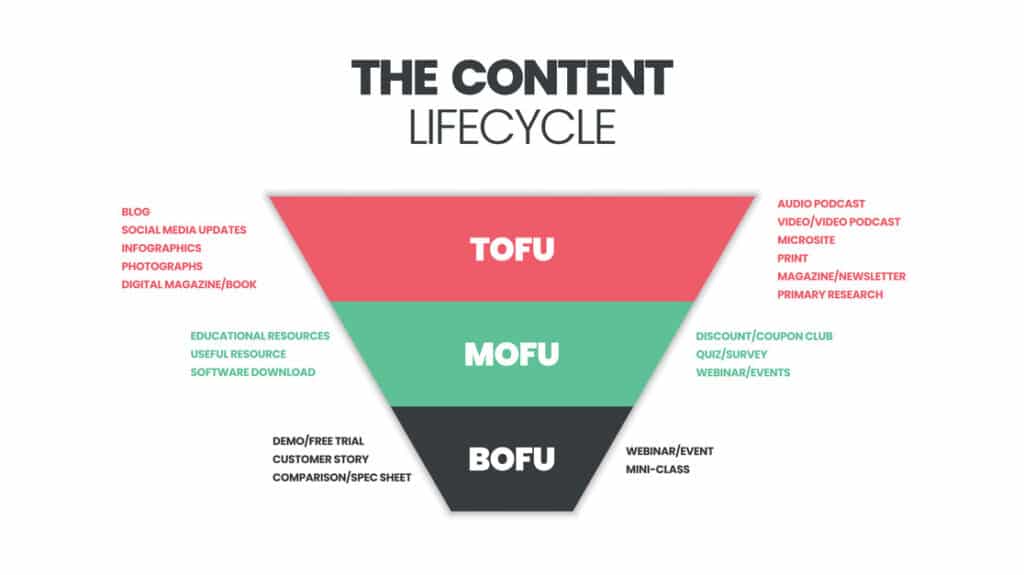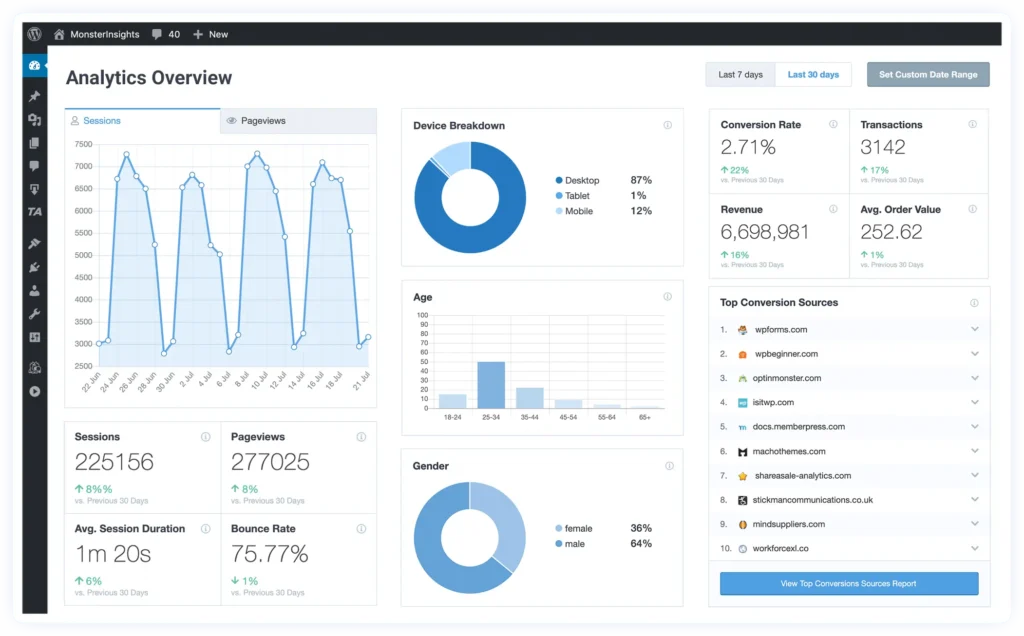B2B SEO is the secret weapon that separates thriving companies from those struggling to find qualified leads. When decision-makers search for solutions to their business problems, a strategic SEO approach ensures your company appears at exactly the right moment.
Most B2B companies leave thousands of qualified leads on the table by overlooking the power of strategic SEO. They simply don’t know how to get started or what to focus on – that’s where I can help.
This step-by-step guide reveals exactly how to build a B2B SEO strategy that delivers qualified leads directly to your business.
I’ll cover:
- What Is B2B SEO?
- B2B SEO vs. B2C SEO: What's Different?
- How to Build an Effective B2B SEO Strategy
- Step #1: Build Your Decision-Maker Persona
- Step #2: Choose Your Bottom of the Funnel Keywords
- Step #3: Find Top of the Funnel Topics
- Step #4: Optimize Your Product and Services Pages
- Step #5: Create an Insanely Valuable B2B Blog
- Step #6: Build Backlinks For Your B2B Website
- Step #7: Measure and Refine Your Strategy
- FAQ About B2B SEO
What Is B2B SEO?
B2B search engine optimization (SEO) is a digital marketing strategy designed to help your business website rank higher in search engines like Google.
Unlike B2C SEO, B2B SEO focuses on keywords that decision-makers within companies search for while researching solutions for their business problems.
When done right, B2B SEO brings qualified leads directly to your business by positioning your website in front of people actively looking for your products or services.
B2B SEO vs. B2C SEO: What’s Different?
Is B2B SEO fundamentally different from B2C SEO? Well, yes and no.
Google doesn’t have a separate “B2B algorithm.” The technical ranking factors are identical for both B2B and B2C websites. However, in practice, B2B SEO operates quite differently:
Key Differences:
- Target Audience: Instead of targeting broad consumer groups, B2B SEO targets specific decision-makers at companies. These might be CTOs, marketing managers, or procurement specialists.
- Keyword Volume: B2B keywords typically have much lower search volume. While a B2C keyword might get 40,000+ monthly searches, a valuable B2B keyword might only get 50-100 searches per month.
- Complex Sales Funnels: B2B buying cycles are longer and involve multiple stakeholders, requiring content for each stage of the decision-making process.
- Higher Value Conversions: While conversion rates may be lower, the value of each conversion is typically much higher in B2B.
- Content Focus: B2B content needs to demonstrate expertise and thought leadership rather than emotional appeal.
Now, let’s dive into the step-by-step process for creating an effective B2B SEO strategy.
How to Build an Effective B2B SEO Strategy
Step #1: Build Your Decision-Maker Persona

Before you can target the right keywords, you need to know exactly who you’re trying to reach.
In B2C, your target audience is straightforward: it’s the end consumer. But in B2B, you’re targeting specific decision-makers within businesses who have the power to purchase your solution.
To create an effective decision-maker persona, ask yourself:
- What job titles do your buyers hold?
- What are their main responsibilities?
- What problems are they trying to solve?
- What metrics do they care about?
- What questions do they ask during the buying process?
HubSpot’s free Make My Persona tool is excellent for this step. It walks you through the process of creating detailed buyer personas that will inform your entire SEO strategy.
For example, if you sell accounting software for small businesses, your primary decision maker might be:
- CFO or Finance Director at companies with 10-50 employees
- Responsible for financial reporting and cash flow management
- Looking to reduce manual data entry and accounting errors
- Measured on cost savings and efficiency improvements
Step #2: Choose Your Bottom of the Funnel Keywords

Now that you know who you’re targeting, it’s time to identify the keywords they use when they’re ready (or almost ready) to buy. These are your bottom-of-the-funnel keywords, or BOFU for short.
How to Find Bottom of the Funnel B2B Keywords:
- Use the Seed Keywords Engine: This free tool helps you discover how real people search for your products or services. Create a scenario like “You need a new CRM for your sales team” and send it to people who match your buyer personas.
- Google Autocomplete: Type the beginning of a search term related to your product and see what Google suggests. This reveals actual search queries people use.
- Competitor Keyword Analysis: Use SEO tools like Semrush or Ahrefs to analyze what keywords your competitors rank for. Filter for keywords with high commercial intent.
- Focus on High CPC Keywords: Keywords with high cost-per-click (CPC) values in Google Ads often indicate high commercial intent. A keyword with a $12+ CPC shows that businesses are willing to pay good money for each click because these visitors convert well.
Pro Tip: Don’t dismiss keywords with low search volume. In B2B, a keyword that gets only 100 searches per month but has a high CPC can be incredibly valuable if those searchers are your exact target customers.
Step #3: Find Top of the Funnel Topics
While bottom of the funnel keywords drive conversions, top of the funnel keywords build awareness and bring more visitors into your marketing funnel.
These keywords typically:
- Have a higher search volume
- Answer questions and solve problems
- Build awareness of your brand
- Establish your expertise
For example, if you sell payroll software, your bottom-of-the-funnel keyword might be “best payroll program”, while your top of the funnel keyword could be “how to do payroll” (1,400 monthly searches).
Tools for Finding Top of the Funnel Topics:
- ExplodingTopics.com: Discover trending topics in your industry before they become mainstream.
- Google’s “People Also Ask”: Check what related questions appear when you search for your main keywords.
- BuzzSumo: Find content that’s performing well in your industry, which can inspire your own topics.
Remember, the strategy with top of the funnel content is to provide value first, capture email addresses, and nurture those leads until they’re ready to buy.
Step #4: Optimize Your Product and Services Pages
Now it’s time to optimize your product and service pages for the bottom of the funnel keywords you identified in Step #2.
Here are three crucial strategies for optimizing B2B landing pages:
1. Create 100% Unique Content
Every product or service page needs completely unique content. Google doesn’t like duplicate content, and it won’t rank pages that are too similar to each other.
This can be challenging if you have several similar services or location pages, but it’s essential for SEO success.
Read our guide on Landing Page Best Practices to Maximize Conversions (Tested).
2. Develop Long-Form Content
Most B2B landing pages are too thin, with only 50-100 words of content. These short pages struggle to rank because Google doesn’t have enough information to understand what the page is about.
Our recent ranking factors analysis found that the average result on Google’s first page contains 1,447 words.
Aim to write at least 500-1,000 words for important landing pages, covering:
- Detailed product features and benefits
- Use cases and applications
- Technical specifications
- FAQs
- Client testimonials
3. Use Smart Keyword Placement
Include your target keyword strategically throughout the page:
- In the H1 headline and title tag
- In the page URL
- Within the first 50 words
- In at least one subheading (H2)
- Naturally throughout the body content
- In the meta description
Don’t overdo it with keyword stuffing. Instead, use synonyms and related terms to make your content read naturally while still being optimized for search.
Check out: On-page SEO in WordPress: Your Complete Guide.
Step #5: Create an Insanely Valuable B2B Blog

Blogging is a crucial component of any successful B2B SEO strategy because it helps you target top-of-the-funnel keywords and build authority in your industry.
Here are three key strategies for your B2B blog:
1. Focus on Shoulder Topics
Many B2B companies make the mistake of only writing about their products directly. Instead, focus on “shoulder topics” – topics that are related to your product but not directly about it.
For example, if you sell accounting software, don’t just write about “5 Features to Look for in Accounting Software.” Instead, create content about “How to Prepare for Tax Season” or “Small Business Bookkeeping Tips.”
Shoulder topics attract a wider audience and build trust before pushing for a sale.
Read How to Create a Content Strategy (Backed by Real Data) to learn a lot more.
2. Create Ultimate Guides
Ultimate guides work exceptionally well for B2B content marketing. These comprehensive resources:
- Position yourself as an authority
- Attract backlinks from other websites
- Provide massive value to readers
- Rank well for competitive keywords
3. Use a “Business Casual” Writing Style
Most B2B content is painfully boring. While you should maintain professionalism, your content doesn’t need to be stiff and formal.
Instead, use a “business casual” writing style that’s:
- Professional but conversational
- Easy to read and engaging
- Includes personal touches and examples
- Uses simple language to explain complex concepts
This approach makes your content more enjoyable to read and helps build a connection with your audience.
Step #6: Build Backlinks For Your B2B Website
Link building is essential for SEO success, especially in competitive B2B industries. Here are three effective link-building strategies specifically for B2B businesses:
1. Digital PR
Instead of targeting mainstream media, focus your PR efforts on industry blogs and news sites that your target customers actually read.
For example, a marketing blog could publish a survey about SEO service providers and get featured on industry websites like Search Engine Journal. This type of mention brings targeted traffic and valuable backlinks.
To implement this strategy:
- Create original research or surveys related to your industry
- Package the data into an easily digestible format with charts and key findings
- Reach out to industry publications with a personalized pitch
If you’re on WordPress, you can use MonsterInsights to easily monitor your referral traffic. The Source/Medium report shows you exactly where your visitors are coming from and what drives conversion:

If you see that a specific traffic source is performing well, create a strategy around increasing this flow of visitors.
2. Develop Helpful Tools and Calculators
People love linking to helpful tools, and they don’t need to be complicated to attract links.
For example, Freightos created a simple Freight Rate Calculator that has earned over 200 backlinks from relevant websites.
Consider what small tool, calculator, or template would be valuable to your target audience, then create and promote it.
3. Leverage Partner Pages
Many businesses have pages that list their partners, suppliers, or technology integrations, and these often include links.
To implement this strategy:
- Make a list of all your business partners, vendors, suppliers, and clients
- Check if they have partner pages or directories on their websites
- Reach out and ask to be added with a link to your site
This approach is simple yet effective for building relevant, high-quality backlinks!
Step #7: Measure and Refine Your Strategy
The final step is to track your results and continuously refine your strategy based on the data.
Key metrics to monitor include:
- Organic traffic growth
- Keyword rankings
- Conversion rates from organic traffic
- Time on page and bounce rates
- Backlink acquisition
Use tools like Google Analytics and Google Search Console to track these metrics, and make adjustments to your strategy based on what’s working and what’s not.
Or, if you’re running on WordPress, use MonsterInsights!
MonsterInsights is the best Google Analytics plugin for WordPress, allowing you to see exactly what your visitors are doing on your website. It transforms complex analytics data into easy-to-understand reports right inside your WordPress dashboard.

With MonsterInsights, you get access to comprehensive reports that reveal which content resonates with your B2B audience, what search terms bring visitors to your site, and which marketing channels drive the most valuable traffic.
This visibility is crucial for refining your SEO strategy and focusing your efforts where they’ll have the biggest impact.
If you’re running an eCommerce website, MonsterInsights offers advanced eCommerce tracking capabilities. Set up in just a few clicks, you can track conversions, monitor shopping behavior, view top-selling products, and see the complete customer journey from first visit to purchase – all without writing a single line of code.
Powerful Features for B2B SEO Success:
- Form Tracking: See exactly which forms generate the most leads
- Search Console Integration: Discover the exact keywords driving traffic to your site
- File Download Tracking: Monitor downloads of your whitepapers and resources
- Custom Dimensions: Track content by category, author, or custom metrics
- Affiliate Link Tracking: Measure which partnerships drive the most value
- Real-Time Stats: See who’s on your site and what they’re viewing right now
- And much more!
Want to know which marketing channels bring in the most qualified leads? MonsterInsights shows you exactly where your visitors come from and which sources convert best, helping you allocate your B2B marketing budget more effectively.
FAQ About B2B SEO
What makes B2B SEO different from B2C SEO?
B2B SEO targets business decision-makers rather than consumers, focuses on lower-volume but higher-intent keywords, addresses longer sales cycles with multiple stakeholders, and emphasizes thought leadership and expertise over emotional appeal.
How long does it take to see results from B2B SEO?
Most B2B companies start seeing initial results within 3-6 months, with significant improvements typically occurring after 6-12 months of consistent effort. The timeline depends on your industry competition, website authority, and the quality of your SEO strategy.
Should I focus more on bottom or top of the funnel keywords?
You need both. Bottom of the funnel keywords drive immediate conversions but have limited volume. Top of the funnel keywords build awareness, attract more visitors, and feed your sales funnel. A balanced approach targeting both types will yield the best long-term results.
How important are backlinks for B2B SEO?
Extremely important. In competitive B2B industries, backlinks remain one of the strongest ranking factors. Quality matters more than quantity – links from relevant industry publications and authoritative websites in your niche carry the most weight.
What is the most common B2B SEO mistake?
The most common mistake is creating content focused only on your products rather than addressing the questions and challenges your potential customers face. Successful B2B SEO requires understanding your audience’s entire journey and creating content for each stage of that journey.
Can B2B companies succeed with SEO in all industries?
Absolutely! In fact, “boring” or smaller industries often have less SEO competition. The key is finding the specific problems your audience is trying to solve and creating high-quality content that addresses those needs better than your competitors.
That wraps up my complete guide on B2B SEO. I hope you liked it and learned a lot of helpful tips. I recommend you also check out:
- How to Create Cornerstone Content That Ranks
- 16 Content Marketing Metrics That Matter the Most
- Improve Content Marketing ROI in 10 Steps
- 8 Best SEO Content Checker Tools for Content Optimization
Finally, don’t forget to follow us on YouTube for more helpful reviews, tutorials, and Google Analytics tips.
